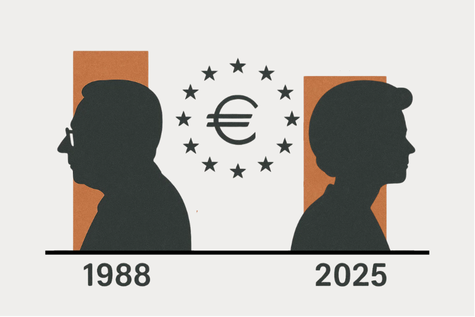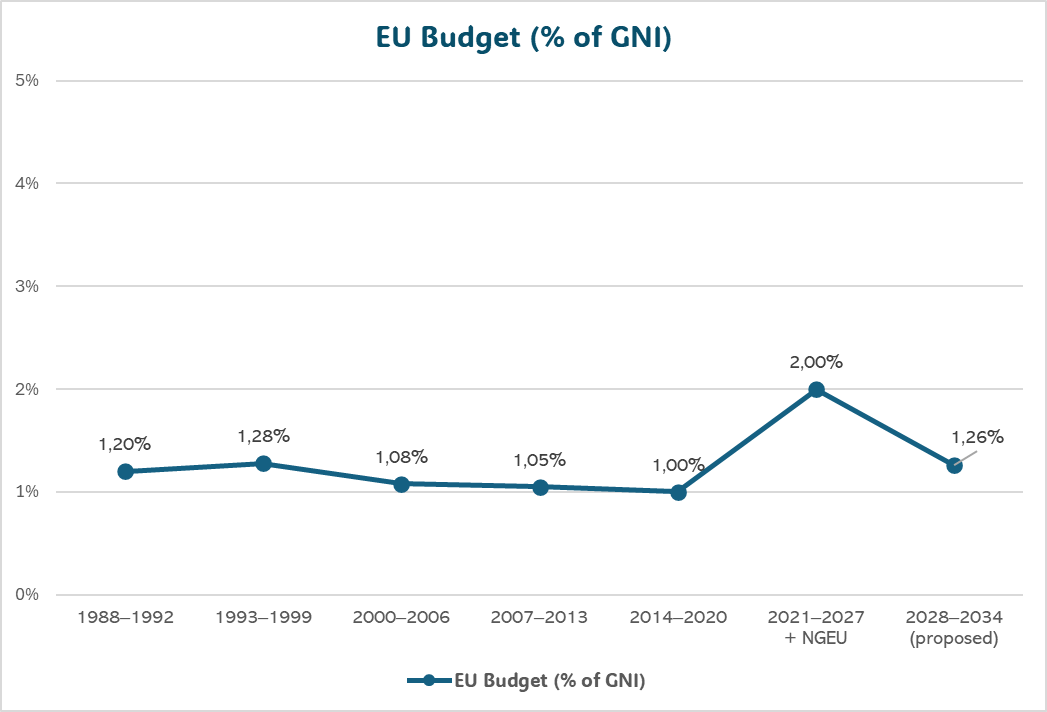The project for the New Europe
The problem with the budget

Vision Paper by Francesco Grillo, Valerio Rosa and Silvia Scarafoni.
Elaboration of an article originally published in Il Messagero by Francesco Grillo.
The European Union did not exist in 1988. Instead, there was the European Economic Community, comprising 12 states (one of which was still divided in two). In June of that year, Jacques Delors succeeded in persuading the Community to adopt a real budget. Since then, the number of member countries, the powers of the community institutions, and the issues to be addressed have grown. Ursula von der Leyen, who inherited Delors' complex legacy, has proposed what she calls the 'most ambitious' budget the Union has ever seen. Yet Delors' budget represented a higher proportion (1.2%) of the GDP of EEC countries than that proposed by the Commission a few days ago (1.15%). It is in these figures that the contradiction lies from which the Union and its budget cannot escape. The real problem is not the amount of resources Europe can invest. It is the rigidity of the project to which the Commission is trying to react. Even if we manage to achieve little, if we cannot start a real debate on what the Union will need in 2025, budget decisions will follow.
In fact, the Union's spending capacity has always fluctuated within a very narrow range, from 1.28% (between 1993 and 1999, coinciding with the project's maximum expansion) to 1% (between 2014 and 2020) of the Union's GDP. The only exception is the current spending cycle, for which the budget has almost doubled to 2%, thanks to transfers made possible by the first major joint debt operation (Next Generation EU, totalling €750 billion), which was launched in response to the pandemic emergency. We will have to repay this starting from the next cycle. This is an indication of rigidity in itself, compounded by the need to plan spending cycles lasting seven years. In the last seven years alone, we have experienced so many changes that it is impossible to plan a budget law that will remain valid for such a long period.

Source: EU Commission
In seven years, our current priorities – defence and immigration – could be overshadowed by technological and geopolitical phenomena reflecting technological developments, as well as unpredictable environmental issues.
These are, of course, the main concerns for those, such as the current President of the European Commission, who are trying to navigate transformations for which there is no nautical map. The Commission's proposal has two key merits: first, the mechanism through which it proposes to simplify the reallocation of resources when new priorities emerge; and second, the mechanism through which it proposes to activate loans (as with Next Generation EU) in the event of a crisis affecting a country. However, we need to be more courageous. This does not necessarily mean spending more but rather designing a budget that is consistent with the challenges, and with the mission entrusted to the Commission by the Treaties. This means disengaging the Union from policies that individual countries can pursue themselves and increasing its responsibility where acting together would clearly be advantageous.
For example, there is no clear reason why the Union should directly support the income of ten million European farmers, or why the Commission should be responsible for the economic development of 281 regions (including developed ones - few people know that Île-de-France and London have also received structural funds). The Commission is right to propose reducing the weight of these policies (the overall weight of agricultural and cohesion policies in the budget will fall from 62% to 42%). It is also right to gradually replace the criterion for accessing payments with proof that the allocated resources have been spent on achieving specific objectives, as was the case with Next Generation EU.
And yet, when it comes to cohesion policies, we need to specify what the European Commission should be doing more of. It must use its privileged position, which enables it to compare national experiences and observe global developments, to generate knowledge that is useful to policymakers.
Sources:
European Commission Commission Communication on a Dynamic EU Budget for the Priorities of the Future – The Multiannual Financial Framework 2028–2034. Link
European Commission. EU Budget in the Past. Link

